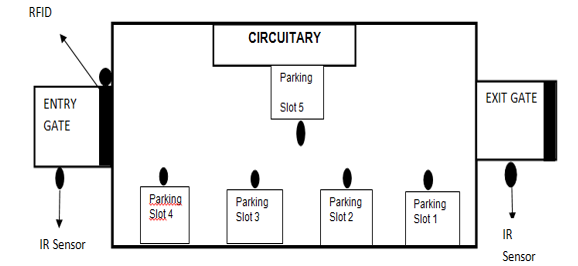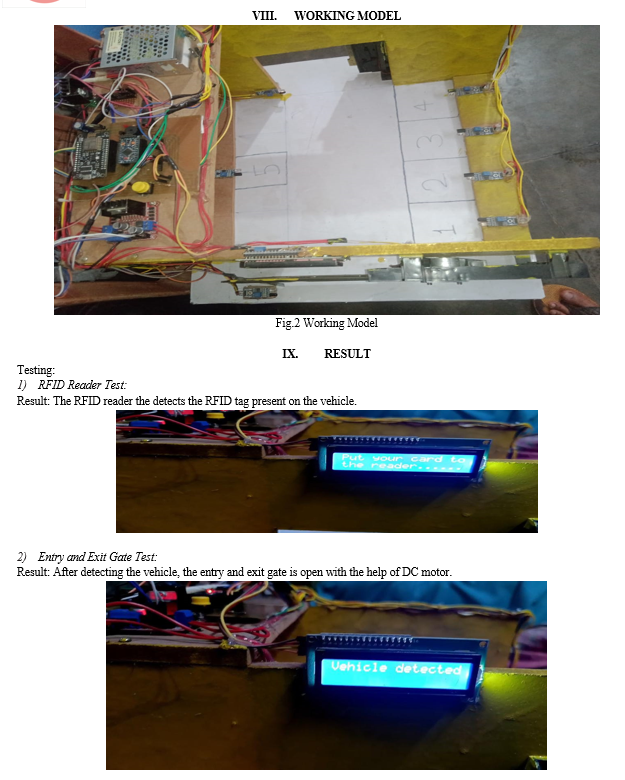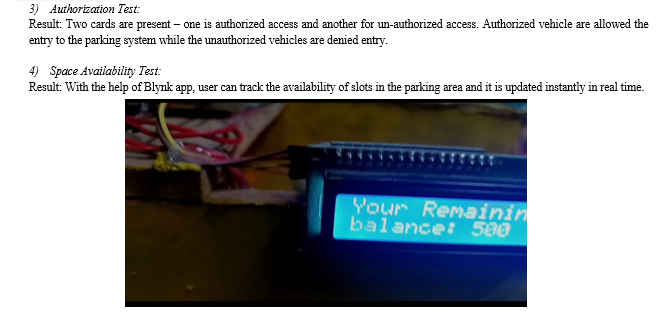Ijraset Journal For Research in Applied Science and Engineering Technology
- Home / Ijraset
- On This Page
- Abstract
- Introduction
- Conclusion
- Copyright
IOT Based Smart Parking System
Authors: Shashank Agnihotri, Ankit Kumar, Gopal Singh, Prateek Dixit, Shayan Ahmad, Shresth Chaurasia
DOI Link: https://doi.org/10.22214/ijraset.2024.61888
Certificate: View Certificate
Abstract
The problem faced by people in this modern era in urban areas is the problem of parking whether it is in shopping mall, railway station, hospitals, movie theatre, etc. This problem occurs due the increase of number of vehicles in recent times. Furthermore, today’s car parking is insufficient and driver/users waste most of the time in finding a place to park their vehicles. The purpose of this research is to use modern technologies like IoT (Internet of Things) and RFID (Radio-Frequency Identification) which detects the availability of parking slots in the parking lots. Besides, the smart parking system has a web application which displays how many slots are available and alerts the user when status of the slot has changed. Additionally, the user details are added on the database. Hence, the smart parking system will provide a smooth functioning and will take the parking system to new levels.
Introduction
I. INTRODUCTION
Nowadays, in India and other countries people are buying more and more cars due to which many problems occur like road accidents, parking problem, traffic jams, wastage of fuel and energy and may more. One of the most common and significant problem faced is parking related problem, this problem occur due to insufficient car parking in India. Moreover, the parking systems which are present are mostly conventional, inefficient and managed by staff or manpower. Most of the places in India have no parking systems, therefore the problem still exists. This problem mostly occur in places like department stores, hospitals, government offices, educational institutions, etc. where vehicles gather on same place on a regular basis. People mostly waste their time in looking for a place to park their vehicle, which also wastes their fuel. Based on previous studies which were done relevant to the parking lot or parking management system, it is found that the most of the parking lot systems present in India are conventional systems in which staff record the data of the users/drivers in register which is not at all an effective way. In this conventional way, the staff cannot record that how many cars are present in the parking lot and how many more cars can be parked in the parking. However, due to advancements in technology and the internet we can now build a smart parking system. In this smart parking system the use of sensors, RFID devices and microcontrollers is there.
The research studies relevant to the smart parking system revealed that the use of computer and network technology and electronic components can be done to create a smart parking system in many ways. A smart parking will consist of sensors which will detect any sort of objects (cars) in front of them and tell whether the slot is vacant or occupied, it will also consist of microcontroller which will store all sort of information and for also providing internet assistance and an application or an website which interacts with user and also store the information of the user.
In order to solve the problem the researcher proposed the design and development of a smart parking system, this system uses IoT (Internet of Things) and also the RFID (Radio-Frequency Identification) to create an efficient smart parking system. This would help the user to know whether the slots are vacant or occupied. This system will allow to minimize the problem that people are facing related to parking and also to impress the users so that more smart parking systems are built in future.
II. LITERATURE SURVEY
A. IoT Based Smart Parking Model Using Arduino UNO & FCFS
Smart parking system can be build using IoT platform, where all the stakeholders can be a part of the system. The problem is much focused on parking slot allocation based on user given priority with IoT platform to make parking location smart system operated with the help of automation explain in four different layers.
- Advantages
- System can be used and applied anywhere due to ease of usage.
- Because it is based on FCFS so the user who will come first in the parking area will get the parking slot first.
2. Disadvantages
- Cost of implementation is high.
- The microcontroller will have to take a lot of load which can crash the system.
B. Smart Parking System using IoT
A wireless sensor along with mobile application is being used to find the parking space. In this system, onboard circuits are used to communicate with other vehicles. It connects the user with real time traffic status via Google API.
- Advantages
- It enhances the security by detecting the vehicle number plate using camera.
- It avoids traffic congestion by using phone app that connects the user with real time traffic status.
2. Disadvantages
- Car parking space must be registered in the smart parking system for the user to use it.
- No guidance is provided in the parking lot.
C. Applying Smart Parking System With IoT Design
The IoT enables to integrate the uses of sensors and CCTVs with current database management system. The AWS cloud server provides facilities for interfacing gateway devices such as Raspberry Pi.
- Advantages
- Paperless tickets and cashless payments solve the problem of missing ticket.
- The system used the mobile Bluetooth for identification and registration.
2. Disadvantages
- This system depends on power sources. In the event of power outages or device failures, users may face difficulties in accessing parking facility.
- No guidance is provided in the parking lot.
D. Parking System Based On Image Processing
A unique identification number is required and for this number plate can be a useful identification by identifying and capturing with the help of number plate. This will help in finding a vacant slot in the parking area. The system uses efficient algorithms and techniques for extracting license plate text.
- Advantages
- This system captures the image of parking slots and then it will provide information about availability of parking space.
- Security is enhanced because every vehicle is captured in camera so if any mishappening happens then it will be caught on camera.
2. Disadvantages
1. Weather conditions may affect the working of camera. The camera should be placed at a good position.
2. This does not provide the reservation facility for car parking.
III. PROBLEM STATEMENT
Finding the available parking space for the vehicles nowadays is cumbersome, especially in urban areas. There are not enough spaces in urban areas to park the car. This leads to traffic congestion, wastage of time and fuel and frustration among the drivers. Also the parking spaces which are present is not secure as it does not keep a check on vehicles that are parked.
It may increase the threat of illegal parking. Guards cannot allow selective parking due to lack of proper identification system. So IoT based system is developed which can solve this issue. In this drivers can quickly check the availability of vacant of slots using his mobile app or website and he can book his slot. This system uses various sensors to check the availability of slots and it will pass this information to the microcontroller which will further send this data to database and driver can know the status of the car parking. The parking slots are regularly monitored and data is continuously updated in the display board. This system also denies the access of unauthorized person because of the use of RFID technology.
IV. WORKING PRINCIPLE
This system consists of three sections: first section is the parking area which includes Arduino Uno along with IR sensor. The user interacts with the parking area using these devices. Only authorized person with a valid RFID card with have access to the parking lot.
If the car number is matched with the saved number in the database then Arduino will allow the car to park in secured area.IR sensor checks the availability of vacant slots and it will be displayed on the screen. When the car exits the parking area then RFID card which has been recharged is used to pay the bill which is displayed on LCD screen. Second section contains the cloud based web services which acts as a mediator between user and parking area. An admin is present which monitors all the database and updates the status of parking lots in the mobile app and it administers the cloud services and it can be viewed by the user. The third section is the user side which uses the parking system. User can view the parking slots in his mobile app and can book the slot before he reaches the parking area.
V. METHODOLOGY
In this system, two technologies are used: IoT and RFID. This allow the user to find the nearest parking area. This will help in reducing the time in finding the parking area and also avoids the traffic. Every car has their own RFID tag attached on it. When the car reaches the parking area, in the center an RFID reader is fixed. Now the reader will scan the tag which contains all the information of the user. The data is send to the backend where the data of the user is already saved when books the slot. If the data is matched then Arduino will give the instruction to open the gate and user is allowed to enter the area. An IR sensor detects the status of each parking space and determines if there is a car or not. If there is no car present and space is available, it is represented in green color and if there is a car parked then it is represented by red color. Users are notified of this data. Now there is a timer which is present in each slot which will count the duration of the parked car. The total amount is calculated in the mobile app and user will use to pay the bill. RFID reader is present at the exit gate which has been recharged and it can be used to pay the amount.
VI. PROJECT MODEL


VII. IMPLEMENTATION
- Step 1-The user has to register himself on the app through the RFID card which stores his information on the server. This is a necessary step for authentication. After registering himself on the app, he can checkout for a free parking space.
- Step 2- Once registration is done, user must the available parking area on the website and select the desired parking slot. Green color indicated the un-booked slot and the red color indicates the booked slot.
- Step 3- After checking the status, user can book his slot by providing his details. In this way his slot is booked and he can go to parking area where RFID reader is fixed to identify and authenticate the user.
- Step 4- Before generating the bill, IR sensor and RFID tags work together to know which vehicle is being parked, and depending on the time and amount, the bill is generated.
- Step 5- Node MCU is used which performs all the functions with the help of internet. Payment is done through online booking. All these data is stored in the database.
- When the user scans the RFID tags over RFID reader, it reads the details and the data is sent to the database. Following cases are below:
a. Case 1: When user details is matched.
- Checks for arrival time entered in website.
- Checks for sufficient balance present in RFID card.
b. Case 2: When user details is not matched.
- User uses wrong RFID tags or he has not registered for that slot.
- The booked slot will be cancelled.



X. FUTURE SCOPE
As this system will come in daily use and change the life of people, new features could be added. QR code could be used in place of RFID card for verification and it can also be used for payment facility. Another feature can greatly help the people. Nowadays there is an increasing demand of Electric Vehicles (EV) and it will continue to surge in future also. So another slots can be made for EVs in which charging stations are installed. So it will serve the two purposes: firstly the parking of EVs and secondly it can be charged for that duration of time till the time it is being parked. For regular customers, discounts or rewards could be given. Further uses could be that mobile application be developed for Android as well as IOS operating system in order to make it more practical. Integration of environmental sensors in the parking system can promote the eco-friendly transportation options.
Conclusion
Smart city has become a necessity in today’s world and the advancements are being done on a daily basis to make it a reality. New technologies are developed like IoT and cloud technology to make it a possibility. Smart parking is a very important feature of smart cities. It has been the core of constructing smart cities. The current scenario of parking system is not smart and it consumes a lot of time and fuel is wasted. So this project will help in making the city smart by using IoT and RFID card technology. By using this technology, this system provides seamless entry and exit processes, real time monitoring of parking occupancy and convenient payment options. The project is aimed at enhancing parking infrastructure by reducing traffic congestion and traffic jams on the road. This innovative solutions can play a crucial role in addressing parking related issues and the present challenges of all traffic issues. This will enhance the quality of life for its residents and increase the sustainable urban development.
Copyright
Copyright © 2024 Shashank Agnihotri, Ankit Kumar, Gopal Singh, Prateek Dixit, Shayan Ahmad, Shresth Chaurasia. This is an open access article distributed under the Creative Commons Attribution License, which permits unrestricted use, distribution, and reproduction in any medium, provided the original work is properly cited.

Download Paper
Paper Id : IJRASET61888
Publish Date : 2024-05-10
ISSN : 2321-9653
Publisher Name : IJRASET
DOI Link : Click Here
 Submit Paper Online
Submit Paper Online

